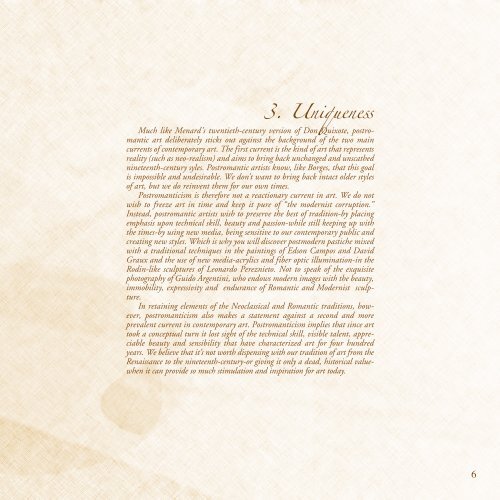Postromanticism The Art of Passion - Claudia Moscovici
Postromanticism The Art of Passion - Claudia Moscovici
Postromanticism The Art of Passion - Claudia Moscovici
Create successful ePaper yourself
Turn your PDF publications into a flip-book with our unique Google optimized e-Paper software.
3. Uniqueness<br />
Much like Menard’s twentieth-century version <strong>of</strong> Don Quixote, postromantic<br />
art deliberately sticks out against the background <strong>of</strong> the two main<br />
currents <strong>of</strong> contemporary art. <strong>The</strong> first current is the kind <strong>of</strong> art that represents<br />
reality (such as neo-realism) and aims to bring back unchanged and unscathed<br />
nineteenth-century syles. Postromantic artists know, like Borges, that this goal<br />
is impossible and undesirable. We don’t want to bring back intact older styles<br />
<strong>of</strong> art, but we do reinvent them for our own times.<br />
<strong>Postromanticism</strong> is therefore not a reactionary current in art. We do not<br />
wish to freeze art in time and keep it pure <strong>of</strong> “the modernist corruption.”<br />
Instead, postromantic artists wish to preserve the best <strong>of</strong> tradition-by placing<br />
emphasis upon technical skill, beauty and passion-while still keeping up with<br />
the times-by using new media, being sensitive to our contemporary public and<br />
creating new styles. Which is why you will discover postmodern pastiche mixed<br />
with a traditional techniques in the paintings <strong>of</strong> Edson Campos and David<br />
Graux and the use <strong>of</strong> new media-acrylics and fiber optic illumination-in the<br />
Rodin-like sculptures <strong>of</strong> Leonardo Pereznieto. Not to speak <strong>of</strong> the exquisite<br />
photography <strong>of</strong> Guido Argentini, who endows modern images with the beauty,<br />
immobility, expressivity and endurance <strong>of</strong> Romantic and Modernist sculpture.<br />
In retaining elements <strong>of</strong> the Neoclassical and Romantic traditions, however,<br />
postromanticism also makes a statement against a second and more<br />
prevalent current in contemporary art. <strong>Postromanticism</strong> implies that since art<br />
took a conceptual turn it lost sight <strong>of</strong> the technical skill, visible talent, appreciable<br />
beauty and sensibility that have characterized art for four hundred<br />
years. We believe that it’s not worth dispensing with our tradition <strong>of</strong> art from the<br />
Renaissance to the nineteenth-century-or giving it only a dead, historical valuewhen<br />
it can provide so much stimulation and inspiration for art today.<br />
6


